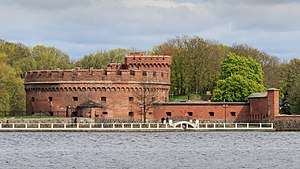Königsberg fortifications
The fortifications of the former East Prussian capital Königsberg (now Kaliningrad) consist of numerous defensive walls, forts, bastions and other structures. They make up the First and the Second Defensive Belt, built in 1626—1634 and 1843—1859, respectively.[2] The 15 metre-thick First Belt was erected due to Königsberg's vulnerability during the Polish–Swedish wars.[2] The Second Belt was largely constructed on the place of the first one, which was in a bad condition.[2] The new belt included twelve bastions, three ravelins, seven spoil banks and two fortresses, surrounded by a water moat.[2] Ten brick gates served as entrances and passages through defensive lines and were equipped with moveable bridges.[2]

The Königsberg fortifications became largely obsolete even before the completion of construction due to the rapid development of artillery.[2] Following the military setbacks of Nazi Germany, however, they became strategically important again (particularly during the East Prussian Offensive).
Major fortifications
Astronomic Bastion
The Astronomic Bastion was erected in 1855-1860 and got its name because of proximity to the Königsberg Observatory.[3] The bastion's wall was demolished in 1910.[3] Subsequently the bastion was used to accommodate the Russian OMON for some time.[4] Later the structure was bought by the Russian MP Asanbuba Niudyurbegov.[4]
Bronsart Fort
The Bronsart Fort (German: Bronsart bei Mandein) was constructed in 1875-80 and is named after General Paul Bronsart von Schellendorff. It did not suffer much during military actions, remaining in quite good condition.[3]
Dohna Tower
The Dohna Tower (German: Dohnaturm) was built in 1858 in Neo-Romanesque style[1] and is named after Friedrich Ferdinand Alexander zu Dohna-Schlobitten. Following its restoration after World War II the tower started to accommodate the Amber Museum.
Friedrich Wilhelm I Fort
The King Friedrich Wilhelm I Fort, originally known as Quednau, is the largest fort of Königsberg.[3]
Gneisenau Fort
The two-storeyed Gneisenau Fort was named after August von Gneisenau. It was heavily damaged by Soviet troops during World War II.[3]
Grolman Bastion
The erection of Grolman Bastion, which was named after General Karl Wilhelm von Grolman, was finished in 1851. It is strengthened with casemates and caponniers inside its wall and consists of lesser Oberteich and Kupferteich Bastions.
Pillau Citadel
The construction of stone Pillau Citadel started in the beginning of the 17th century. The citadel gained its final appearance by the beginning of the 18th century.
Stein Fort
The large Stein Fort was named after Prussian statesman Henrich von Stein. It remained in better condition than some other fortifications because it lay a bit aside from the places of the main Soviet attacks during World War II.
Minor structures
Barnekow Fort
The Barnekow Fort is one of the small forts, named after Prussian General Albert von Barnekow.[3]
Notes
- "Museums of Kaliningrad". Tourism Kaliningrad. Archived from the original on 2010-12-25. Retrieved 2011-01-01.
- "The Past..." Museum of the World Ocean. Archived from the original on 2011-03-10. Retrieved 2011-01-01.
- "Fortifications". Tourism Kaliningrad. Archived from the original on 2010-12-25. Retrieved 2011-01-01.
- "Asanbuba Banished the OMON Men" (in Russian). Pravyye Novosti. Archived from the original on 2011-08-23. Retrieved 2011-01-01.
| Wikimedia Commons has media related to Königsberg fortifications. |